usedto的用法小结
- 格式:doc
- 大小:19.00 KB
- 文档页数:2
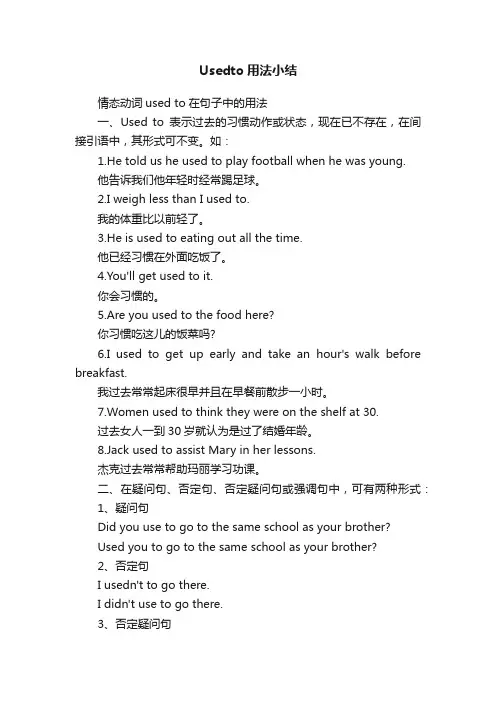
Usedto用法小结情态动词used to在句子中的用法一、Used to表示过去的习惯动作或状态,现在已不存在,在间接引语中,其形式可不变。
如:1.He told us he used to play football when he was young.他告诉我们他年轻时经常踢足球。
2.I weigh less than I used to.我的体重比以前轻了。
3.He is used to eating out all the time.他已经习惯在外面吃饭了。
4.You'll get used to it.你会习惯的。
5.Are you used to the food here?你习惯吃这儿的饭菜吗?6.I used to get up early and take an hour's walk before breakfast.我过去常常起床很早并且在早餐前散步一小时。
7.Women used to think they were on the shelf at 30.过去女人一到30岁就认为是过了结婚年龄。
8.Jack used to assist Mary in her lessons.杰克过去常常帮助玛丽学习功课。
二、在疑问句、否定句、否定疑问句或强调句中,可有两种形式:1、疑问句Did you use to go to the same school as your brother?Used you to go to the same school as your brother?2、否定句I usedn't to go there.I didn't use to go there.3、否定疑问句Usen't you to be interested in the theatre?Didn't you use to be interested in the theatre?4、强调句I certainly used to smoke,but it was a long time ago.I certainly did use to smoke,but it was a long time ago.5、其反意疑问句或简略回答中,也有两种形式:She used to be very fat,didn't she? (口语+常用)/ use(d)n't she? (正式+过时)Did you use to play chess? Yes,I did.Used you to get up early in the morning? Yes,I did. (Yes,I used to.)Used to 用法小结01 一、掌握used to的构成used to+动词原形,其中to是不定式符号02 二、掌握used to用法。
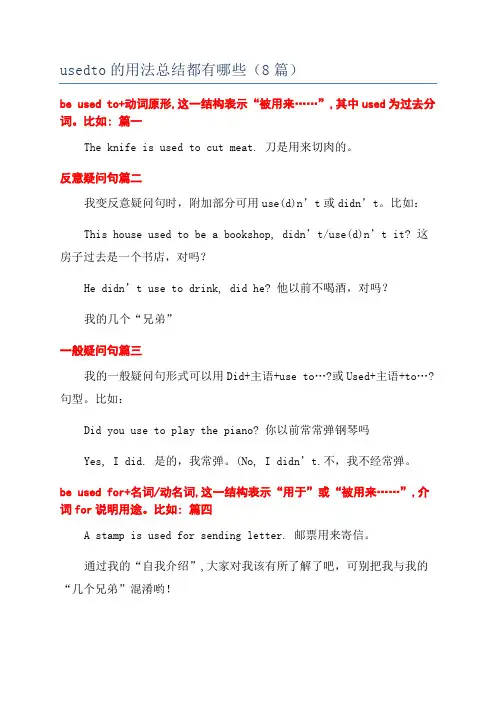
usedto的用法总结都有哪些(8篇)be used to+动词原形,这一结构表示“被用来……”,其中used为过去分词。
比如: 篇一The knife is used to cut meat. 刀是用来切肉的。
反意疑问句篇二我变反意疑问句时,附加部分可用use(d)n’t或didn’t。
比如:This house used to be a bookshop, didn’t/use(d)n’t it? 这房子过去是一个书店,对吗?He didn’t use to drink, did he? 他以前不喝酒,对吗?我的几个“兄弟”一般疑问句篇三我的一般疑问句形式可以用Did+主语+use to…?或Used+主语+to…?句型。
比如:Did you use to play the piano? 你以前常常弹钢琴吗Yes, I did. 是的,我常弹。
(No, I didn’t.不,我不经常弹。
be used for+名词/动名词,这一结构表示“用于”或“被用来……”,介词for说明用途。
比如: 篇四A stamp is used for sending letter. 邮票用来寄信。
通过我的“自我介绍”,大家对我该有所了解了吧,可别把我与我的“几个兄弟”混淆哟!【趁热打铁】用used to, be used to, get used to, be used for 填空:1. She ____ be a history teacher.2. The pen ____ writing.3. His father ____ drinking coffee after suppr.4. This machine ____ make bread.5. Her mother ____ tell stories when she was young.6. There ____ be an old house near the lake.7. She ____ cold weather after having lived here for two years.Key:ed to 2.is used for 3.gets used to4.is used ed ed to 7.was/got used ed, tonot to have long hair.) 她以前没有长头发。
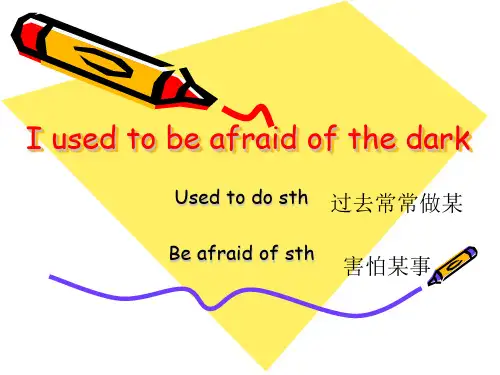
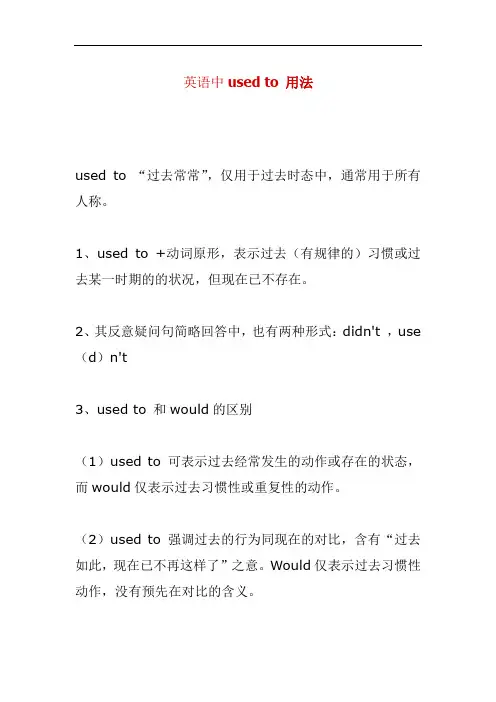
英语中used to 用法
used to “过去常常”,仅用于过去时态中,通常用于所有人称。
1、used to +动词原形,表示过去(有规律的)习惯或过去某一时期的的状况,但现在已不存在。
2、其反意疑问句简略回答中,也有两种形式:didn't ,use (d)n't
3、used to 和would的区别
(1)used to 可表示过去经常发生的动作或存在的状态,而would仅表示过去习惯性或重复性的动作。
(2)used to 强调过去的行为同现在的对比,含有“过去如此,现在已不再这样了”之意。
Would仅表示过去习惯性动作,没有预先在对比的含义。
(3)used to不能跟表确定时间短的时间状语连用。
(4)used to 可用于无人称句和存在句,而would则不可。
4、used to与be used to do和be used to doing
(1)used to表示“过去常常”隐含现在不这样了,其中to是不定式符号,后跟动词原形,仅用于过去时态。
(2)be/get/become used to 表示“习惯于”时,意为“变得习惯于“或“开始习惯于”。
(3)be used to do表示“被用来”。
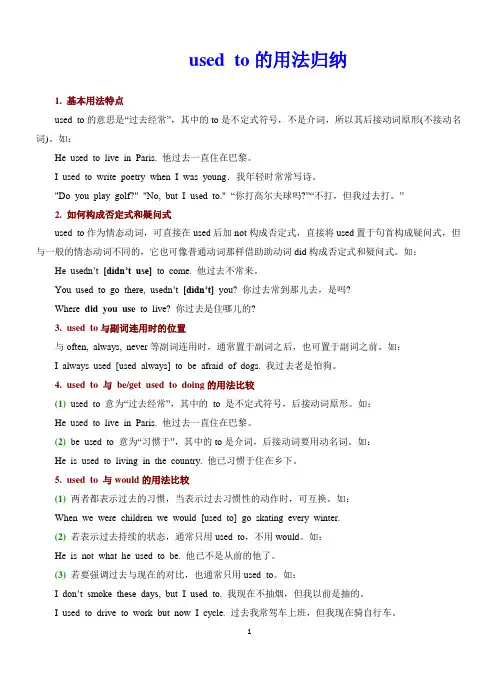
used to的用法归纳1. 基本用法特点used to的意思是“过去经常”,其中的to是不定式符号,不是介词,所以其后接动词原形(不接动名词)。
如:He used to live in Paris. 他过去一直住在巴黎。
I used to write poetry when I was young.我年轻时常常写诗。
"Do you play golf?" "No, but I used to." “你打高尔夫球吗?”“不打,但我过去打。
”2. 如何构成否定式和疑问式used to作为情态动词,可直接在used后加not构成否定式,直接将used置于句首构成疑问式,但与一般的情态动词不同的,它也可像普通动词那样借助助动词did构成否定式和疑问式。
如:He usedn’t [didn’t use] to come. 他过去不常来。
You used to go there, usedn’t[didn’t] you? 你过去常到那儿去,是吗?Where did you use to live? 你过去是住哪儿的?3. used to与副词连用时的位置与often, always, never等副词连用时,通常置于副词之后,也可置于副词之前。
如:I always used [used always] to be afraid of dogs. 我过去老是怕狗。
4. used to 与be/get used to doing的用法比较(1)used to 意为“过去经常”,其中的to 是不定式符号,后接动词原形。
如:He used to live in Paris. 他过去一直住在巴黎。
(2)be used to 意为“习惯于”,其中的to是介词,后接动词要用动名词。
如:He is used to living in the country. 他已习惯于住在乡下。
5. used to 与would的用法比较(1)两者都表示过去的习惯,当表示过去习惯性的动作时,可互换。
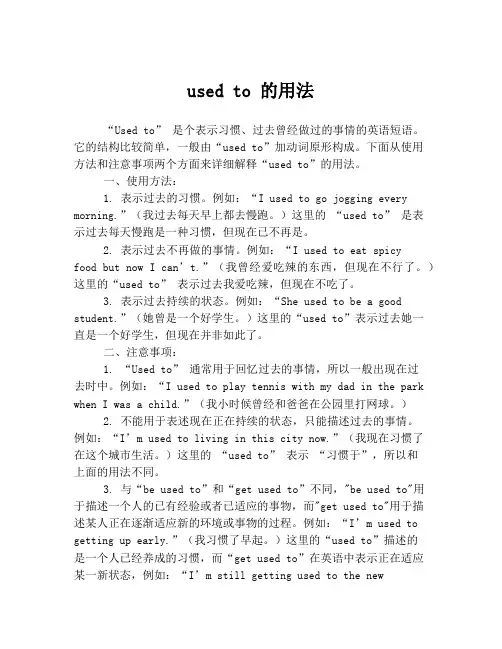
used to 的用法“Used to” 是个表示习惯、过去曾经做过的事情的英语短语。
它的结构比较简单,一般由“used to”加动词原形构成。
下面从使用方法和注意事项两个方面来详细解释“used to”的用法。
一、使用方法:1. 表示过去的习惯。
例如:“I used to go jogging every morning.”(我过去每天早上都去慢跑。
)这里的“used to” 是表示过去每天慢跑是一种习惯,但现在已不再是。
2. 表示过去不再做的事情。
例如:“I used to eat spicyfood but now I can’t.”(我曾经爱吃辣的东西,但现在不行了。
)这里的“used to” 表示过去我爱吃辣,但现在不吃了。
3. 表示过去持续的状态。
例如:“She used to be a good student.”(她曾是一个好学生。
)这里的“used to”表示过去她一直是一个好学生,但现在并非如此了。
二、注意事项:1. “Used to” 通常用于回忆过去的事情,所以一般出现在过去时中。
例如:“I used to play tennis with my d ad in the park when I was a child.”(我小时候曾经和爸爸在公园里打网球。
)2. 不能用于表述现在正在持续的状态,只能描述过去的事情。
例如:“I’m used to living in this city now.”(我现在习惯了在这个城市生活。
)这里的“used to” 表示“习惯于”,所以和上面的用法不同。
3. 与“be used to”和“get used to”不同,"be used to"用于描述一个人的已有经验或者已适应的事物,而"get used to"用于描述某人正在逐渐适应新的环境或事物的过程。
例如:“I’m used to getting up early.”(我习惯了早起。
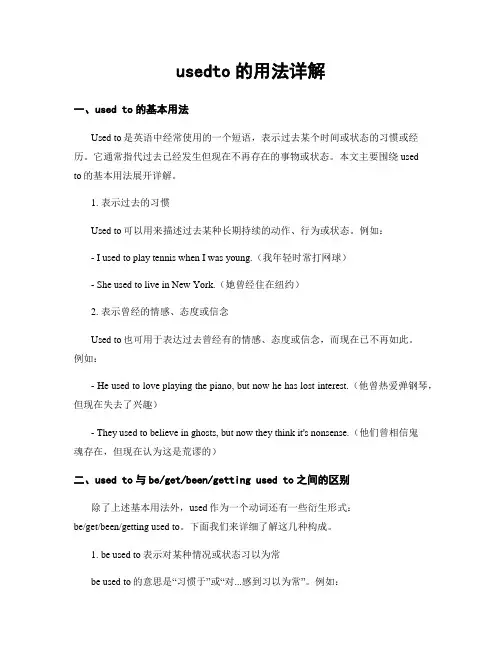
usedto的用法详解一、used to的基本用法Used to是英语中经常使用的一个短语,表示过去某个时间或状态的习惯或经历。
它通常指代过去已经发生但现在不再存在的事物或状态。
本文主要围绕usedto的基本用法展开详解。
1. 表示过去的习惯Used to可以用来描述过去某种长期持续的动作、行为或状态。
例如:- I used to play tennis when I was young.(我年轻时常打网球)- She used to live in New York.(她曾经住在纽约)2. 表示曾经的情感、态度或信念Used to也可用于表达过去曾经有的情感、态度或信念,而现在已不再如此。
例如:- He used to love playing the piano, but now he has lost interest.(他曾热爱弹钢琴,但现在失去了兴趣)- They used to believe in ghosts, but now they think it's nonsense.(他们曾相信鬼魂存在,但现在认为这是荒谬的)二、used to与be/get/been/getting used to之间的区别除了上述基本用法外,used作为一个动词还有一些衍生形式:be/get/been/getting used to。
下面我们来详细了解这几种构成。
1. be used to表示对某种情况或状态习以为常be used to的意思是“习惯于”或“对...感到习以为常”。
例如:- I am used to the hot weather here now. (我现在已经适应了这里的炎热天气)- She is used to working late nights.(她习惯晚上加班)2. get used to表示逐渐适应某种新的事物、环境或情况get used to意为“适应”,常用于表达一个人慢慢、渐渐地适应新环境的过程。
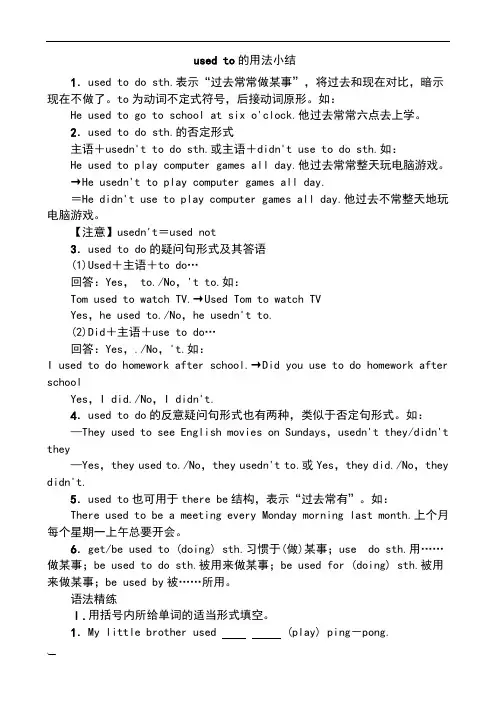
used to的用法小结1.used to do sth.表示“过去常常做某事”,将过去和现在对比,暗示现在不做了。
to为动词不定式符号,后接动词原形。
如:He used to go to school at six o'clock.他过去常常六点去上学。
2.used to do sth.的否定形式主语+usedn't to do sth.或主语+didn't use to do sth.如:He used to play computer games all day.他过去常常整天玩电脑游戏。
→He usedn't to play computer games all day.=He didn't use to play computer games all day.他过去不常整天地玩电脑游戏。
【注意】usedn't=used not3.used to do的疑问句形式及其答语(1)Used+主语+to do…回答:Yes, to./No,'t to.如:Tom used to watch TV.→Used Tom to watch TVYes,he used to./No,he usedn't to.(2)Did+主语+use to do…回答:Yes,./No,'t.如:I used to do homework after school.→Did you use to do homework after schoolYes,I did./No,I didn't.4.used to do的反意疑问句形式也有两种,类似于否定句形式。
如:—They used to see English movies on Sundays,usedn't they/didn't they—Yes,they used to./No,they usedn't to.或Yes,they did./No,they didn't.5.used to也可用于there be结构,表示“过去常有”。

usedto用法总结归纳Used to用法总结归纳Used to是英语中常用的表达过去习惯或状态的句式,在口语和书面语中都经常出现。
本文将对Used to的用法进行总结和归纳,帮助读者更好地理解和运用这一句式。
一、Used to的基本形式和含义Used to是由used(过去式)和to(不定式)构成的固定搭配,用来表示过去的习惯或状态。
其基本形式为"used to + 动词原形"。
例如:1. I used to go swimming every Sunday when I was a child.(当我还是个孩子的时候,我过去常常去游泳。
)2. He used to smoke a lot, but he quit two years ago.(他过去抽烟很多,但两年前戒了。
)二、Used to的句式结构1. 肯定句:主语 + used to + 动词原形2. 否定句:主语 + didn't use to + 动词原形3. 疑问句:Did + 主语 + use to + 动词原形?例如:1. She used to play the piano when she was young.(她小时候常常弹钢琴。
)2. They didn't use to live in this city.(他们过去不住在这个城市。
)3. Did you use to go camping with your friends?(你过去常常和朋友们一起去野营吗?)三、Used to与现在状态的对比Used to通常用来表示过去的习惯或状态,与现在的情况相对比,可以形成鲜明的对比。
常用的表达方式有"used to...but now..."和"didn't use to...but now..."。
例如:1. I used to love playing video games, but now I prefer reading books.(我过去喜欢玩电子游戏,但现在更喜欢读书。
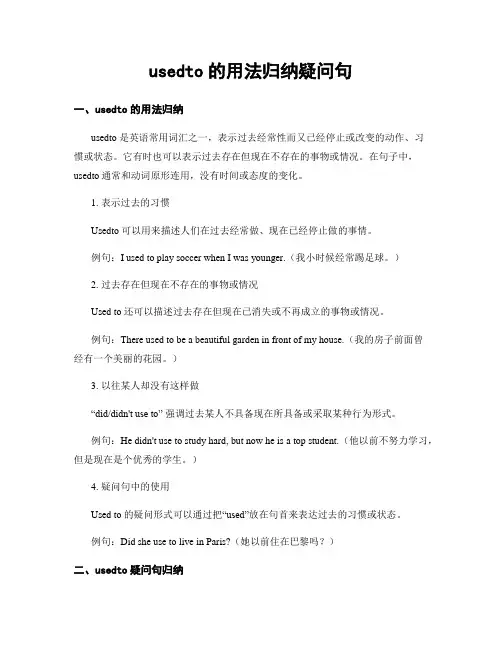
usedto的用法归纳疑问句一、usedto的用法归纳usedto 是英语常用词汇之一,表示过去经常性而又已经停止或改变的动作、习惯或状态。
它有时也可以表示过去存在但现在不存在的事物或情况。
在句子中,usedto通常和动词原形连用,没有时间或态度的变化。
1. 表示过去的习惯Usedto 可以用来描述人们在过去经常做、现在已经停止做的事情。
例句:I used to play soccer when I was younger.(我小时候经常踢足球。
)2. 过去存在但现在不存在的事物或情况Used to 还可以描述过去存在但现在已消失或不再成立的事物或情况。
例句:There used to be a beautiful garden in front of my house.(我的房子前面曾经有一个美丽的花园。
)3. 以往某人却没有这样做“did/didn't use to” 强调过去某人不具备现在所具备或采取某种行为形式。
例句:He didn't use to study hard, but now he is a top student.(他以前不努力学习,但是现在是个优秀的学生。
)4. 疑问句中的使用Used to 的疑问形式可以通过把“used”放在句首来表达过去的习惯或状态。
例句:Did she use to live in Paris?(她以前住在巴黎吗?)二、usedto疑问句归纳1. Yes/No 疑问句这种疑问句用于询问某人过去是否拥有某种经常性的行为、状态或做法,回答只需简单地回答“yes”或“no”。
例句:- Did he use to play the piano?- Yes, he did.- No, he didn't.2. Wh- 疑问句这类疑问句一般用于询问关于过去的经常性行为、状态或做法的具体细节。
例句:- When did you use to travel to Europe every year?- I used to travel to Europe every summer during my college years.3. Would instead of usedto 疑问句有时,人们可以使用"would"来表示过去经常性的动作或情况。

used to的用法小结1.used to do sth.表示“过去常常做某事”,将过去和现在对比,暗示现在不做了。
to为动词不定式符号,后接动词原形。
如:He used to go to school at six o'clock.他过去常常六点去上学。
2.used to do sth.的否定形式主语+usedn't to do sth.或主语+didn't use to do sth.如:He used to play computer games all day.他过去常常整天玩电脑游戏。
→He usedn't to play computer games all day.=He didn't use to play computer games all day.他过去不常整天地玩电脑游戏。
【注意】usedn't=used not3.used to do的疑问句形式及其答语(1)Used+主语+to do…回答:Yes,to./No,'t to.如:Tom used to watch TV.→Used Tom to watch TVYes,he used to./No,he usedn't to.(2)Did+主语+use to do…回答:Yes,./No,'t.如:I used to do homework after school.→Did you use to do homework after schoolYes,I did./No,I didn't.4.used to do的反意疑问句形式也有两种,类似于否定句形式。
如:—They used to see English movies on Sundays,usedn't they/didn't they—Yes,they used to./No,they usedn't to.或Yes,they did./No,they didn't.5.used to也可用于there be结构,表示“过去常有”。
used to的用法和搭配
be used for+时间“被用了……时间”,be used to+名词/动名词“习惯于……”,used to“过去常常……”,be used to do“被用做干什么”,be used to doing“现在习惯于做什么”,used to do“过去曾作过什么”。
扩展资料
use的.常见用法有:
1、be used to do被用来做什么。
需要注意:be used to的主语是人时,其意为“习惯于”;be used to的主语不是人而是物时,则为被动语态,意为“被用于”。
如:He has been used to living in the city.他已经在城市里住惯了。
2、used to do仅用于一般过去时,表示过去常常做什么。
(否定式为used not to do或didn't use to do,疑问式把used放句首,或把did放句首)Scarf used to take a walk.Scarf过去常常散步。
3、be used to doing习惯做什么,Scarf is used to taking a walk.Scarf现在习惯于散步。
辨析:
(1)used to do sth.“过去常常做某事”
to后加动词原形,否定句为didn't use to或used not to。
(2)be used to do sth.“被用来做某事”
to后加动词原形。
(3)be used to doing sth“习惯做某事”
to是介词,后加名词,动名词或代词。
关于used to的用法及解释used to的用法其实是初中必考内容,不知道同学们掌握了没有?接下来小编在这里给大家带来used to的用法,我们一起来看看吧!used to的用法一、作名词 1. 作用途解是可数名词。
Can you find a use for these empty boxes? 你能给这些空盒子派上用场吗? I need a tool with many uses. 我需要一件有多种用途的工具。
2. 作使用; 效用; 使用权解是不可数名词。
多用于以下的固定短语中。
1) (be) in use 正在使用。
The dictionary is in use. 词典正被使用。
2) (be) of use有用处;起作用。
The cellphone is of great use. 手机很有用。
3) make (good / full ) use of (好好 / 充分)利用 We should make full use of every minute in order to learn English well. 为了学好英语,我们应该充分利用每一分钟。
此外,还有come into use(开始使用),have the use of(有权使用),There is no use doing sth. / It's no use doing sth. (做某事没有用)等搭配。
二、作动词 1. 使用;运用。
As a student, you should learn how to use a dictionary. 作为学生,你应该学会如何使用词典。
2.与for或as连用,构成短语use...for,意为用来做......;为了......而使用, use... as为作为......使用;用作......之意。
Bamboo can be used for carrying water. 竹子可以用来运水。
Used to 用法小议used to do sth.意思是“过去常常做某事”,表示过去经常做或一直做而现在不做,它只用于过去时态。
(一)肯定句式:主语+used to+动词原形……例如:I used to go to the cinema,but I never have time now.我过去经常去看电影,但现在没有时间了。
He used to listen to pop music but now he likes rock music.他过去总听流行音乐,但现在喜欢摇滚了。
(二)否定句式:A)主语+did not use to+动词原形……B)主语+used not to+动词原形……第一种否定句型,就是把used当做实义动词来看,所以变否定句要用助动词did;第二种否定句是把used当做情态动词,变否定句直接在used后面加not即可,used not能够缩写成usedn't或usen't。
美式英语通常用A种形式,英式英语常用B种形式。
例如:You didn't use to drink.你过去不喝酒。
The shop usedn't to open on Sundays. 过去这家商店星期天不营业。
(三)一般疑问句式:A)Did+主语+use to+动词原形……?B)Used+主语+to+动词原形……?美式英语通常用A种形式,英式英语用B种形式。
例如:Did you use to go swimming in the river when you were young?你小时候经常在河里游泳吗?Used he go to school by bike?他过去骑车上学吗?(四)used to用于省略句时,肯定式保留to,否定式不保留to。
例如:——Used you play basketball?——你过去常打篮球吗?——Yes, I used to.(No,I usedn't.)——是的,经常打。
used to 的用法和搭配一、什么是"used to"?"Used to" 是一个表达过去习惯性或经常发生情况的短语,常用于肯定句和否定句中。
它表示过去的状态、行为或习惯在现在已经不再存在。
它的基本结构为"used to + 原型动词"。
1.1 过去习惯行为"Used to" 用来描述在过去某一段时间内反复发生或持续存在的习惯性行为。
比如:I used to walk my dog every morning.(我过去常常每天早晨遛狗)1.2 过去形容状态除了描述过去经常发生的行为,"used to" 也可表示一种过去曾有但现在不再具备的状态。
例如:He used to be very shy when he was a child.(他小时候非常害羞)二、 "used to" 的语法用法2.1 肯定句结构在肯定句中,我们使用"used to + 动词原型" 的形式来表示过去的习惯或状态,其中动词原型不随人称和时态变化。
例如:- We used to live in the countryside when I was young.(当我年轻时,我们住在乡下)- She used to work in a bank before she started her own business.(她开始自己创业前曾在银行工作)2.2 否定句结构在否定句中,用 "did not use to + 动词原型" 的形式来表示过去的否定习惯或状态。
例如:- I did not use to enjoy swimming, but now I love it.(过去我不喜欢游泳,但现在很喜欢)- They did not use to drink coffee, but now they can't start their day without it.(过去他们不喝咖啡,但现在一天不能没有它)2.3 疑问句结构在疑问句中要使用辅助动词 "did" 加上主语和"use to" 来提问过去的习惯或状态。
used to的意思摘要:一、used to的含义二、used to的用法1.表示过去经常发生的动作或状态2.表示习惯或倾向3.表示过去的技能或能力4.用于否定句和疑问句三、used to与过去时的区别四、实用例句正文:used to是一个英语短语,它的意思是“过去经常做某事”或“过去习惯于某事”。
used to常用来描述过去某个时期内的常态或习惯性行为。
在英语语法中,used to属于情态动词,它后面要接动词的原形。
ed to表示过去经常发生的动作或状态。
例如:- She used to go swimming in the summer.(她过去经常在夏天去游泳。
)- He used to smoke cigarettes.(他过去抽烟。
)ed to表示习惯或倾向。
例如:- She used to be late for school.(她过去总是上学迟到。
)- They used to live in the city.(他们过去住在城市里。
)ed to表示过去的技能或能力。
例如:- I used to play the piano.(我过去会弹钢琴。
)- She used to speak French fluently.(她过去法语讲得很流利。
)ed to用于否定句和疑问句。
例如:- He doesn"t used to drink coffee in the morning.(他过去不习惯早上喝咖啡。
)- Did you used to live in this city?(你过去住在这个城市吗?)需要注意的是,used to与过去时有所区别。
过去时表示过去某个时间点发生的动作或状态,而used to表示过去一段时间内的习惯或常态。
例如:- I lived in New York last year.(我去年住在纽约。
)(过去时)- I used to live in New York.(我过去一直住在纽约。
Usedto用法小结Used to是英语中一个常用的结构,表示过去经常做的事情,现在不再做了,相当于中文中的“过去经常”,其基本形式为used to + 动词原形,有时也可用would + 动词原形来表示。
下面是used to用法的小结。
【语法结构】一般将used to视为一个动词短语,由used与to组成。
used to作为一个辅助动词用于表示过去的习惯或经常性行为。
在使用过程中,used to后面的动词一般使用原形,而不使用-ing形式。
肯定句:主语 + used to + 动词原形例如:I used to go to the gym every morning.我过去经常去健身房。
She used to play the piano when she was young.她年轻的时候经常弹钢琴。
否定句:主语 + didn't use to + 动词原形例如:I didn't use to watch TV before going to bed.我以前不在睡觉前看电视。
She didn't use to eat meat, but now she does. 她以前不吃肉,但现在吃了。
疑问句:Did + 主语 + use to + 动词原形?例如:Did you use to take the bus to work?你过去经常坐公交车上班吗?Did she use to live in New York City?她过去住在纽约吗?【常见用法】1. 表示过去的经常性或习惯性动作例如:I used to smoke, but I gave it up.我过去常吸烟,但我戒了。
He used to be a teacher, but now he is a writer.他过去是一名教师,但现在是一名作家。
2. 表示过去的做法或状态例如:She used to live in a small apartment.她以前住在一个小公寓里。
used to的用法小结
1.used to do sth.表示“过去常常做某事”,将过去和现在对比,暗示现在不做了。
to为动词不定式符号,后接动词原形。
如:
He used to go to school at six o'clock.他过去常常六点去上学。
2.used to do sth.的否定形式
主语+usedn't to do sth.或主语+didn't use to do sth.如:
He used to play computer games all day.他过去常常整天玩电脑游戏。
→He usedn't to play computer games all day.
=He didn't use to play computer games all day.他过去不常整天地玩电脑游戏。
【注意】usedn't=used not
3.used to do的疑问句形式及其答语
(1)Used+主语+to do…
回答:Yes,to./No,'t to.如:
Tom used to watch TV.→Used Tom to watch TV
Yes,he used to./No,he usedn't to.
(2)Did+主语+use to do…
回答:Yes,./No,'t.如:
I used to do homework after school.→Did you use to do homework after school
Yes,I did./No,I didn't.
4.used to do的反意疑问句形式也有两种,类似于否定句形式。
如:
—They used to see English movies on Sundays,usedn't they/didn't they
—Yes,they used to./No,they usedn't to.或Yes,they did./No,they didn't.
5.used to也可用于there be结构,表示“过去常有”。
如:
There used to be a meeting every Monday morning last month.上个月每个星期一上午总要开会。
6.get/be used to (doing) sth.习惯于(做)某事;use do sth.用……做某事;be used to do sth.被用来做某事;be used for (doing) sth.被用来做某事;be used by 被……所用。
语法精练
Ⅰ.用括号内所给单词的适当形式填空。
1.My little brother used (play) ping-pong.
2.I'm used to (get) up early.
3.Wood is used (make)desks,chairs,tables and so on.
4.you (use) to be short
5.Today,computers (use)in both cities and towns.
Ⅱ.根据汉语提示完成句子,每空一词。
6.He (以前是) a history teacher in our school.
7.There (以前有) an old temple near the village.
8.She (习惯于散步) after supper.
9.Wood (被用来制造) paper.
10.(已习惯于) eating with chopsticks.
Ⅲ.按要求完成下列句子,每空一词。
11.My brother used to play football after school.(改为一般疑问句并作否定回答)
—your brother football after school
—No,he .
12.Tom used to be a quiet boy.(改为否定句)
Tom a quiet boy.
13.There used to be an old hospital behind our school.(完成反意疑问句)
There used to be an old hospital behind our school,
14.I used to see my aunt once__a__month.(对画线部分提问)
you use to see your aunt
15.Mary used to stand at the window and wave goodbye.(改为一般疑问句) Mary stand at the window and wave goodbye。